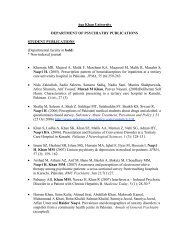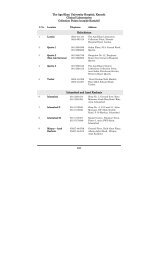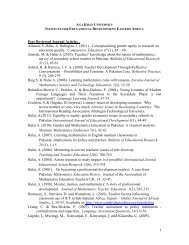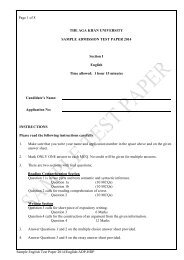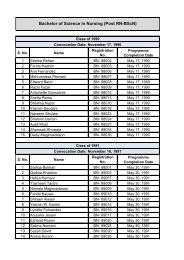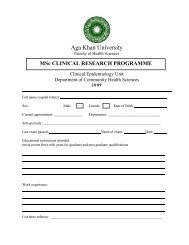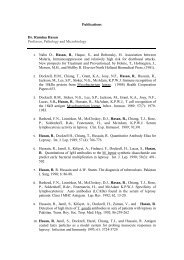Primitive streak formation
Primitive streak formation
Primitive streak formation
Create successful ePaper yourself
Turn your PDF publications into a flip-book with our unique Google optimized e-Paper software.
LCF<br />
Embryogenesis<br />
Dr Ismail Memon<br />
BBS Department<br />
AKU<br />
For<br />
Class of 2016<br />
March 1, 2012
Learning Objectives<br />
• To have three dimensional understanding of<br />
blastocyst, yolk sac, amniotic cavity, epiblast, and<br />
hypoblast<br />
• Identify various areas in the epiblast e.g. primitive<br />
<strong>streak</strong>, buccopharyngeal membrane, cloacal<br />
membrane, prechordal plate<br />
• To have concept of body axes<br />
• To describe the ingression of epiblast cells in<br />
primitive <strong>streak</strong> and <strong>formation</strong> of three germ layers<br />
• To describe the <strong>formation</strong> of notochord<br />
• To describe the fate map of epiblast/ gastrulation<br />
• To describe the developmental changes in<br />
trophoblast and initiation of placenta a <strong>formation</strong>
Third week of development<br />
Gastrulation<br />
• Formation of three germ layers and<br />
body axes<br />
Formation of primitive groove<br />
Formation of primitive <strong>streak</strong><br />
Invagination<br />
Formation three germ layers<br />
Formation of notochord
<strong>Primitive</strong> <strong>streak</strong> <strong>formation</strong><br />
• <strong>Primitive</strong> groove<br />
• <strong>Primitive</strong> pit<br />
• <strong>Primitive</strong> node<br />
• <strong>Primitive</strong> <strong>streak</strong><br />
• Prechordal plate<br />
• Oropharyngeal<br />
membrane<br />
• Cloacal<br />
membrane
Establishment of body axes<br />
• Formation of primitive <strong>streak</strong> determines the<br />
body axes<br />
• The primitive <strong>streak</strong> appears in midline, in<br />
caudal portion of embryonic disc facing to<br />
amniotic cavity<br />
• Part of embryonic disc in front of primitive<br />
<strong>streak</strong> is cranial, hence cranial-caudal axis is<br />
formed<br />
• Looking down the primitive <strong>streak</strong> from<br />
inside the amniotic cavity, what lies to the<br />
right side of the primitive <strong>streak</strong> represent<br />
the right side of the embryo and what lie son<br />
the left , represent the left side, hence left to<br />
right axis is formed<br />
• At the time of primitive <strong>streak</strong> <strong>formation</strong>,<br />
ectodermal view forms dorsal surface and<br />
endodermal view forms ventral surface<br />
hence, dorso-ventral axis is formed
Epiblast cells move<br />
towards primitive <strong>streak</strong>,<br />
undergo epithelial-tomesenchymal<br />
trans<strong>formation</strong>, detach<br />
and sneak in the space<br />
between epiblast and<br />
hypoblast to form three<br />
primary germ layers<br />
Gastrulation
Endoderm <strong>formation</strong><br />
The first ingressing<br />
epiblast cells cells<br />
replace hypoblast cells<br />
and form DEFINITIVE<br />
ENDODERM<br />
The definitive endoderm<br />
gives rise to lining of<br />
future gut and its<br />
derivatives
Mesoderm <strong>formation</strong><br />
• Next population of epiblast<br />
cells coming through<br />
primitive <strong>streak</strong> settles<br />
between epiblast and newly<br />
formed endoderm to form<br />
the INTRAEMBRYONIC<br />
MESODDRM<br />
• Shortly thereafter the<br />
intraembryonic mesoderm is<br />
recognized to form its four<br />
subdivisions:<br />
<br />
<br />
<br />
<br />
cardiogenic mesoderm<br />
paraxial mesoderm<br />
intermediate mesoderm<br />
Lateral plate mesoderm
Ectoderm <strong>formation</strong><br />
• Once the <strong>formation</strong> of<br />
endoderm and mesoderm is<br />
complete, the remaining<br />
epiblast cells do not move to<br />
primitive <strong>streak</strong> and constitute<br />
the ectoderm<br />
• The ectoderm quickly<br />
differentiate into neural plate<br />
and surface ectoderm<br />
• With the <strong>formation</strong> of ectoderm<br />
the process of gastrulation is<br />
complete.
Buccopharyngeal membrane and<br />
• During 3 rd weak, two faint<br />
depressions appear in the<br />
ectoderm<br />
• One lies at cranial end, in front<br />
of prechordal plate and other at<br />
caudal end behind the primitive<br />
<strong>streak</strong><br />
• The ectoderm in both the areas<br />
fuse tightly with the underlying<br />
endoderm, excluding mesoderm<br />
• The cranial membrane is<br />
buccopharyngeal membrane and<br />
caudal is the cloacal membrane<br />
Cloacal membrane
Prechordal plate<br />
• The prechordal plate forms by<br />
ingression of epiblast cells from<br />
primitive node between tip of<br />
notochord and buccopharyngeal<br />
membrane<br />
• It contributes in the <strong>formation</strong> of<br />
oropharyngeal membrane<br />
(endodermal part) and head<br />
mesenchyme hence called<br />
MESENDODERMAL
Formation of Notochord<br />
Notochord <strong>formation</strong><br />
• Prenotochordal cells move through primitive<br />
node to reach the prechordal plate forming a<br />
hollow tube the notochordal process
Notochord <strong>formation</strong><br />
Notochord<br />
• Ventral floor of the tube fuse with<br />
underlying endoderm/hypoblast<br />
• Then separate from endoderm and<br />
form notochordal plate<br />
• At the level of pit, the amniotic<br />
cavity transiently communicates<br />
with yolk sac at neurenteric canal
Notochord<br />
Notochord <strong>formation</strong>…….<br />
• Notochordal plate completely<br />
detach from endoderm and form<br />
definitive notochord between<br />
ectoderm and endoderm<br />
• As it is present in mesodermal<br />
layer hence it is considered as<br />
mesodermal<br />
• It induce forebrain and vertebrae<br />
<strong>formation</strong>
Notochord <strong>formation</strong>…….<br />
During development rudiments<br />
of vertebral bodies coalesce<br />
around the notochord<br />
Notochord serves as basis for<br />
axial skeleton and it form the<br />
nucleus pulposus in the center<br />
of the intervertebral discs
Paraxial mesoderm in Head region<br />
• Paraxial mesoderm flanks notochord<br />
• The paraxial mesoderm in the head region forms bands of unsegmented<br />
cells<br />
• It loosely fills the developing head as head mesenchyme<br />
• It gets supplemented by neural crest cells<br />
• The head mesenchyme gives rise to striated muscles of face, jaw,<br />
and throat
Paraxial mesoderm in trunk region<br />
• The mesoderm in the trunk region forms bands of<br />
segmented cells the somites<br />
• 1 st pair of somites appear on day 20, then somites appear<br />
cranio-caudally 3-4 pair per day till day 30, with final<br />
count of 37 pairs<br />
• Somites give rise to most of axial skeleton, voluntary<br />
muscles of neck, body wall, and limbs and the dermis of<br />
the neck
Intermediate Mesoderm<br />
• It forms in trunk region<br />
only<br />
• It develops lateral to<br />
somites<br />
• It give rise to urinary<br />
system and parts of<br />
genital system
Lateral plate Mesoderm<br />
• It also forms in trunk region only<br />
• It develops lateral to intermediate mesoderm<br />
• It splits into two layers<br />
ventral associated with endoderm called as splanchnic<br />
mesoderm. It forms mesothelial covering of viscera and<br />
parts of wall of viscera<br />
Dorsal associated with ectoderm is called somatic<br />
mesoderm. It forms inner lining of the body wall and<br />
parts of limbs
Fate map of gastrulation<br />
A. Early stage of primitive <strong>streak</strong> showing<br />
prospective (GE) gut endoderm, (PP)<br />
prechordal plate<br />
B. Early stage of primitive <strong>streak</strong> showing<br />
prospective (CM) cardiogenic<br />
mesoderm, (PEEM) prospective<br />
extraembryonic mesoderm<br />
C. Mid stage of indicating prospective<br />
mesoderm (N) notochord, (HM) head<br />
mesoderm, (S) somites, (IM)<br />
intermediate mesoderm, (LPM) lateral<br />
plate mesoderm<br />
D. Elongated stage of primitive <strong>streak</strong><br />
showing prospective (NP) neural plate<br />
(SE) surface ectoderm, (NC) neural<br />
crest cells, (PE) placodal ectoderm
Development of Trophoblast<br />
• During 3 rd week, the trophoblast forms primary villi<br />
• The primary villus consists of core of cytotrophoblast<br />
covered by syncytiotrophoblast<br />
• Mesoderm penetrate the core of primary villi and grow towards<br />
the decidua and form the Secondary villi<br />
• By the end of 3 rd week, the mesenchyme in the core<br />
differentiate into blood cells and blood vessels and form the<br />
tertiary villi
Feto-placental circulation<br />
• The capillaries formed in the tertiary villi establish<br />
contact with capillaries developing in the chorionic<br />
plate and connecting stalk<br />
• These vessels in turn, establish contact with<br />
intraembryonic circulatory system in placent
Feto-placental circulation<br />
• Meanwhile the overlying cytotrophoblast erode the<br />
maternal uterine endometrium<br />
• When the heart start beating, the villi are ready to supply<br />
the embryo with nutrients and oxygen
To be continued………




